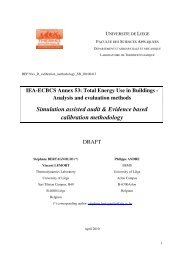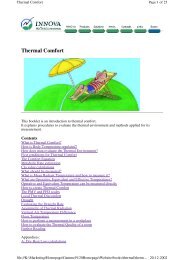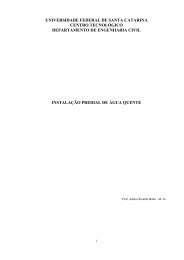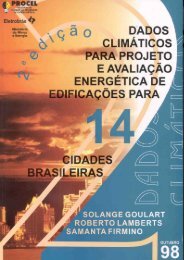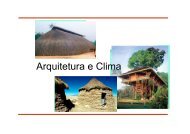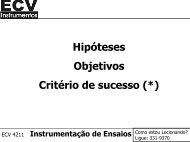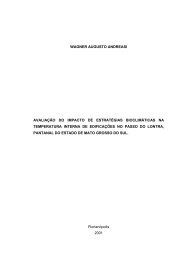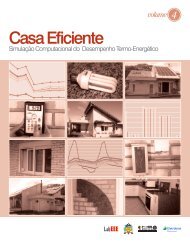Escher
Escher
Escher
Create successful ePaper yourself
Turn your PDF publications into a flip-book with our unique Google optimized e-Paper software.
SCIENCE IN PICTURES<br />
Mšbius Strip II, 1963<br />
<strong>Escher</strong>Õs Metaphors<br />
The prints and drawings of M.C. <strong>Escher</strong><br />
give expression to abstract concepts<br />
of mathematics and science<br />
by Doris Schattschneider<br />
66 SCIENTIFIC AMERICAN November 1994 Copyright 1994 Scientific American, Inc.
Throughout his life Maurits Cornelis<br />
<strong>Escher</strong> (he used only M. C.)<br />
remarked on his inability to<br />
understand mathematics, declaring<br />
himself Òabsolutely innocent of<br />
training or knowledge in the exact<br />
sciences.Ó Yet even as a child,<br />
<strong>Escher</strong> was intrigued by order<br />
and symmetry. The fascination<br />
later led him to study patterns<br />
of tiles at the Alhambra in Granada,<br />
to look at geometric drawings<br />
in mathematical papers (with<br />
the advice of his geologist brother)<br />
and ultimately to pursue his<br />
own unique ideas for tiling a plane.<br />
<strong>Escher</strong>Õs attention to the coloring of<br />
his drawings of interlocked tiles anticipated<br />
the later work of mathematicians and crystallographers<br />
in the Þeld of color symmetry. His<br />
works are now commonly used to illustrate these concepts.<br />
His exhibit in conjunction with the 1954 International Congress<br />
of Mathematicians in Amsterdam and the publication<br />
Copyright 1994 Scientific American, Inc.<br />
Self-Portrait, 1943<br />
M. C. ESCHER views himself in a mirror<br />
in this ÒscratchÓ drawing with<br />
lithographic ink.<br />
of his Þrst book (The Graphic<br />
Work of M. C. <strong>Escher</strong>) in 1959<br />
struck a chord with mathematicians<br />
and scientists that<br />
still resonates strongly. He<br />
wrote that a main impetus<br />
for his work was Òa keen interest<br />
in the geometric laws<br />
contained by nature around us.Ó<br />
In expressing his ideas in graphic<br />
works, he provided arresting visual<br />
metaphors for fundamental ideas in<br />
science.<br />
<strong>Escher</strong> was born in 1898 in the town of<br />
Leeuwarden, Holland. The youngest son of a civil<br />
engineer, he grew up with four brothers in Arnhem. Although<br />
three of his brothers pursued science or engineering,<br />
<strong>Escher</strong> was a poor mathematics student. With the encour-<br />
MOBIUS ¬ STRIP II harbors a procession of ants crawling in an<br />
endless cycle. With a Þnite number of Þgures, <strong>Escher</strong> depicts<br />
inÞnity through the continuous traversal of an<br />
endless loop. The ants demonstrate as well that<br />
this unusual loop (originally printed vertically)<br />
has only one side.<br />
SCIENTIFIC AMERICAN November 1994 67
agement of his high school art teacher,<br />
he became interested in graphic arts,<br />
Þrst making linoleum cuts.<br />
In 1919 he entered the School for Architecture<br />
and Decorative Arts in Haarlem,<br />
intending to study architecture. But<br />
when he showed his work to Samuel Jessurun<br />
de Mesquita, who taught graphic<br />
arts there, he was invited to concentrate<br />
in that Þeld. De Mesquita had a<br />
profound inßuence on <strong>Escher</strong>, both as<br />
a teacher (particularly of woodcut techniques)<br />
and later as a friend and fellow<br />
artist.<br />
After Þnishing his studies in Haarlem,<br />
<strong>Escher</strong> settled in Rome and made many<br />
extensive sketching tours, mostly in<br />
southern Italy. His eyes discerned striking<br />
visual eÝects in the ordinaryÑarchitectural<br />
details of monumental buildings<br />
from unusual vantage points, light<br />
and shadow cast by warrens of staircases<br />
in tiny villages, clusters of houses<br />
clinging to mountain slopes that<br />
plunged to distant valleys and, at the<br />
opposite scale, tiny details of nature as<br />
if viewed through a magnifying glass.<br />
In his studio, he would transform the<br />
sketches into woodcuts and lithographs.<br />
In 1935 the political situation became<br />
unendurable, and with his wife and<br />
young sons, <strong>Escher</strong> left Italy forever. After<br />
two years in Switzerland and then<br />
three years in Uccle, near Brussels, they<br />
Triangle System I B 3 Type 2, 1948<br />
settled permanently in Baarn, Holland.<br />
These years also brought an abrupt turn<br />
in <strong>Escher</strong>Õs work. Almost all of it from<br />
this time on would draw its inspiration<br />
not from what his eyes observed but<br />
rather from his mindÕs eye. He sought to<br />
give visual expression to concepts and<br />
to portray the ambiguities of human observation<br />
and understanding. In doing<br />
so, he often found himself in a<br />
world governed by mathematics.<br />
<strong>Escher</strong> was fascinated, almost<br />
obsessed, with the concept of the<br />
Òregular division of the plane.Ó<br />
In his lifetime, he produced<br />
more than 150 color drawings<br />
that testiÞed to his ingenuity<br />
in creating Þgures that<br />
crawled, swam and soared,<br />
yet Þlled the plane with their<br />
clones. These drawings illustrate<br />
symmetries of many<br />
diÝerent kinds. But for <strong>Escher</strong>,<br />
division of the plane was<br />
also a means of capturing in-<br />
Þnity. Although a tiling such<br />
as the one using butterßies<br />
[see illustration below] can in<br />
principle be continued indefinitely,<br />
thus giving a suggestion<br />
of inÞnity, <strong>Escher</strong> was challenged<br />
to contain inÞnity within<br />
the conÞnes of a single page.<br />
ÒAnyone who plunges into inÞn-<br />
Circle Limit IV,<br />
1960<br />
SYMMETRY is a structural concept that<br />
shapes many mathematical and physical<br />
models. In <strong>Escher</strong>Õs drawing the<br />
butterßies seem to Þll the page randomly,<br />
yet each one is precisely placed<br />
and surrounded in exactly the same<br />
way. Always six (in alternating colors)<br />
swirl about a point where left front<br />
wingtips meet; always three (in different<br />
colors) spin about a point where<br />
right back wings touch; and always<br />
pairs (of different colors) line up the<br />
edges of their right front wings. Along<br />
with rotational symmetry, the drawing<br />
has translational symmetry based<br />
on a triangular grid. The pattern can<br />
continue forever in all directions and<br />
so provides an implicit metaphor of<br />
inÞnity. <strong>Escher</strong>Õs attention to coloring<br />
anticipated discoveries by mathematicians<br />
in the Þeld of color symmetry.<br />
Copyright 1994 Scientific American, Inc.
SELF-SIMILARITY is illustrated in the<br />
print Square Limit, constructed using<br />
a recursive scheme of <strong>Escher</strong>Õs own invention.<br />
A set of directions that is applied<br />
to an object to produce new objects,<br />
then applied to the new objects<br />
and so on, ad inÞnitum, is called a recursive<br />
algorithm. The end product is<br />
self-similar when all the Þnal objects<br />
are the same as the original, except for<br />
changes of scale, orientation or position.<br />
A sketch (top right) sent by <strong>Escher</strong><br />
to the mathematician H.S.M. Coxeter<br />
to explain the print shows that the<br />
underlying grid involves a recursive<br />
splitting of isosceles triangles. In executing<br />
the print, <strong>Escher</strong> carved the<br />
woodblock only for a triangle having<br />
its apex at the center of the square and<br />
its base as one side of the squareÑand<br />
printed the block four times.<br />
Copyright 1994 Scientific American, Inc.<br />
DUALITY is perhaps the most prevalent theme in <strong>Escher</strong>'s later prints. In mathematics, a<br />
statement has a negation, and a set has a complement; in every case, the object and its<br />
dual completely define each other. In Circle Limit IV, there are no outlines. The contours<br />
of the angels and devils deÞne one another. Either is Þgure or ground (<strong>Escher</strong> reminds us<br />
by omitting detail in half the Þgures). In this hyperbolic tiling the Þgures appear to our Euclidean<br />
eyes to become more distorted as they diminish in size. Yet measured by the geometry<br />
intrinsic to the world of the print, every angel is exactly the same size and<br />
shape, and so is every devil. An inÞnite number of copies repeat forever, never<br />
leaving the conÞnes of the circle.<br />
ity, in both time and space, farther<br />
and farther without stopping,<br />
needs Þxed points, mileposts<br />
as he ßashes by, for otherwise<br />
his movement is indistinguishable<br />
from standing<br />
still,Ó <strong>Escher</strong> wrote. ÒHe must<br />
mark oÝ his universe into<br />
units of a certain length,<br />
into compartments which<br />
repeat one another in endless<br />
succession.Ó<br />
After completing several<br />
prints in which Þgures endlessly<br />
diminish in size as<br />
they approach a central vanishing<br />
point [see Whirlpools<br />
on page 71], <strong>Escher</strong> sought a<br />
device to portray progressive<br />
reduction in the opposite direction.<br />
He wanted Þgures that repeated<br />
forever, always approachingÑyet<br />
never reachingÑan encir-<br />
Square Limit, 1964<br />
cling boundary. In 1957 the mathematician<br />
H.S.M. Coxeter sent <strong>Escher</strong> a reprint<br />
of a journal article in which he illustrated<br />
planar symmetry with some<br />
of <strong>Escher</strong>Õs drawings. There <strong>Escher</strong><br />
found a Þgure that gave him Òquite a<br />
shockÓÑa hyperbolic tessellation of tri-
Day and Night, 1938<br />
DIMENSION is that concept which<br />
clearly separates point, line, plane<br />
and space. To illustrate the ambiguities<br />
in the perception of dimension,<br />
<strong>Escher</strong> exploited the printed<br />
pageÑwhich always must fool the<br />
viewer when it depicts a threedimensional<br />
scene. In Day and<br />
Night, the ßat checkerboard of<br />
farmland at the bottom of the print<br />
metamorphoses into two ßocks of<br />
geese. The print also illustrates<br />
the concept of topological change,<br />
in which a Þgure is deformed<br />
without being cut or pierced. Reßection<br />
and duality are present as<br />
well: black geese ßy over a sunlit<br />
village, whereas white ones wing<br />
over a night view of a mirror image<br />
of the same scene.<br />
High and Low, 1947<br />
RELATIVITY states that what an observer sees is inßuenced by context<br />
and vantage point. In the lithograph High and Low, <strong>Escher</strong> presents<br />
two diÝerent views of the same scene. In the lower half the<br />
viewer is on the patio; in the upper half the viewer is looking down.<br />
Now draw back from the print: Is that tiled diamond at the center of<br />
the print a ßoor or a ceiling? <strong>Escher</strong> uses it for both in order to marry<br />
the two views. It is impossible to see the entire print in a logical way.<br />
The scene also illustrates how pasting local views together to form a<br />
global whole can lead to contradictions.<br />
angles that showed exactly the eÝect he sought. From a careful study<br />
of the diagram, <strong>Escher</strong> discerned the rules of tiling in which circular<br />
arcs meet the edge of an encompassing circle at right angles. During<br />
the next three years, he produced four diÝerent prints based on this<br />
type of grid, of which Circle Limit IV [see top illustration on preceding<br />
two pages] was the last.<br />
Four years later <strong>Escher</strong> devised his own solution to the problem of<br />
inÞnity within a rectangle [see bottom illustration on preceding page].<br />
His recursive algorithmÑa set of directions repeatedly applied to an<br />
objectÑresults in a self-similar pattern in which each element is related<br />
to another by a change of scale. <strong>Escher</strong> sent Coxeter a sketch of the<br />
underlying grid, apologizing: ÒI fear that the subject wonÕt be very interesting,<br />
seen from your mathematical point of view, because itÕs really<br />
simple as a ßat Þlling. None the less it was a headaching job to Þnd<br />
an adequate method to realise the subject in the simplest possible way.Ó<br />
In a lecture a few summers ago mathematician William P. Thurston,<br />
director of the Mathematical Sciences Research Institute at the University<br />
of California at Berkeley, illustrated the concept of self-similar<br />
tiling with just such a grid, unaware of <strong>Escher</strong>Õs earlier discovery.<br />
Curiously, self-similar patterns provide examples of Þgures that<br />
DORIS SCHATTSCHNEIDER, professor of mathematics at Moravian College<br />
in Bethlehem, Penn., received her Ph.D. from Yale University in 1966.<br />
Active as a teacher, writer and lecturer, the former editor of Mathematics<br />
Magazine has strong interests in both geometry and art. She is co-author<br />
(with Wallace Walker) of a popular work with geometric models, M. C. <strong>Escher</strong><br />
Kaleidocycles. Her 1990 book, Visions of Symmetry, culminated a research<br />
project on the symmetry studies of M. C. <strong>Escher</strong>.<br />
70 SCIENTIFIC AMERICAN November 1994<br />
Copyright 1994 Scientific American, Inc.
REFLECTION allows phenomena<br />
to be observed that are<br />
too small, too far away or too<br />
obscure to be seen directly.<br />
Puddle directs our eyes to a<br />
woodland trail imprinted by<br />
boots and tiresÑyet in the<br />
puddle are also revealed silhouetted<br />
trees arching overhead<br />
against a moonlit sky.<br />
<strong>Escher</strong> reminds us of the unseen<br />
worlds below, behind<br />
and above our limited gaze.<br />
INFINITY is conÞned within<br />
the Þnite space of a print<br />
in Whirlpools. The artist<br />
draws a ßat projection of the<br />
curve (a loxodrome) that is<br />
traced out on the globe by a<br />
path that cuts across all meridians<br />
at a constant angle.<br />
As any navigator knows, sailing<br />
such a Òrhumb lineÓ results<br />
in a never-ending, ever<br />
tightening spiral about the<br />
earthÕs pole. <strong>Escher</strong> used<br />
one woodblock for both colors.<br />
Printing once for the red,<br />
he turned it halfway around<br />
and printed for the gray.<br />
Puddle, 1952<br />
Copyright 1994 Scientific American, Inc.<br />
Whirlpools, 1957<br />
have fractional, or fractal, dimension, an ambiguity that <strong>Escher</strong><br />
would doubtless have enjoyed. In 1965 he confessed: ÒI cannot<br />
help mocking all our unwavering certainties. It is, for example,<br />
great fun deliberately to confuse two and three dimensions, the<br />
plane and space, and to poke fun at gravity.Ó <strong>Escher</strong> was masterful<br />
at confusing dimensions, as in Day and Night [see upper illustration<br />
on opposite page], in which two-dimensional farm Þelds mysteriously<br />
metamorphose into three-dimensional geese. He also delighted<br />
in pointing out the ambiguities and contradictions inherent<br />
in a common practice of science: pasting together several local<br />
views of an object to form a global whole [see lower illustration on<br />
opposite page].<br />
Near the end of his life (he died in 1972), <strong>Escher</strong> wrote, ÒAbove<br />
all, I am happy about the contact and friendship of mathematicians<br />
that resulted from it all. They have often given me new ideas,<br />
and sometimes there is even an interaction between us. How playful<br />
they can be, these learned ladies and gentlemen!Ó<br />
FURTHER READING<br />
THE GRAPHIC WORK OF M. C. ESCHER. M. C. <strong>Escher</strong>. Ballantine Books,<br />
1971.<br />
THE MAGIC MIRROR OF M. C. ESCHER. B. Ernst. Random House, 1976.<br />
ANGELS AND DEVILS. H.S.M. Coxeter in The Mathematical Gardner.<br />
Edited by David A. Klarner. Prindle, Weber and Schmidt, 1981.<br />
M. C. ESCHER: HIS LIFE AND COMPLETE GRAPHIC WORK. Edited by J. L.<br />
Locher. Harry N. Abrams, 1982.<br />
M. C. ESCHER: ART AND SCIENCE. Edited by H.S.M. Coxeter, M. Emmer, R.<br />
Penrose and M. L. Teuber. North-Holland, 1986.<br />
ESCHER ON ESCHER: EXPLORING THE INFINITE. M. C. <strong>Escher</strong>. Translated<br />
by Karin Ford. Harry N. Abrams, 1989.<br />
VISIONS OF SYMMETRY: NOTEBOOKS, PERIODIC DRAWINGS, AND RELATED<br />
WORK OF M. C. ESCHER. D. Schattschneider. W. H. Freeman and Company,<br />
1990.<br />
SCIENTIFIC AMERICAN November 1994 71




